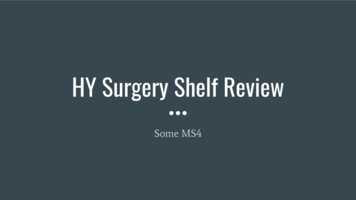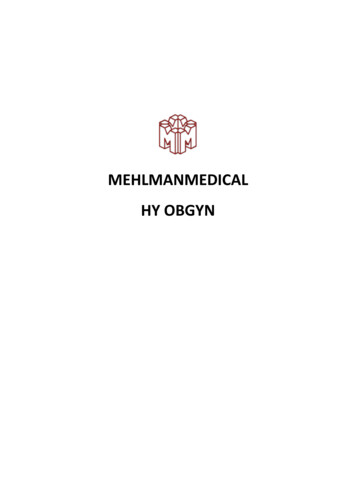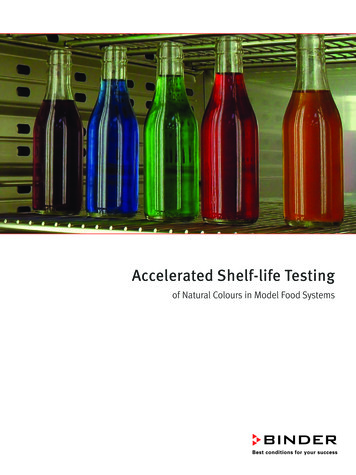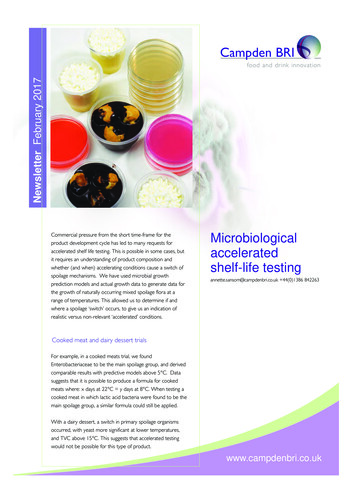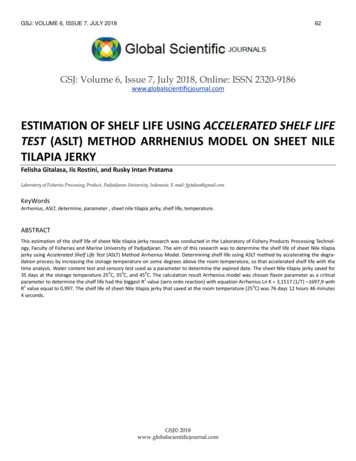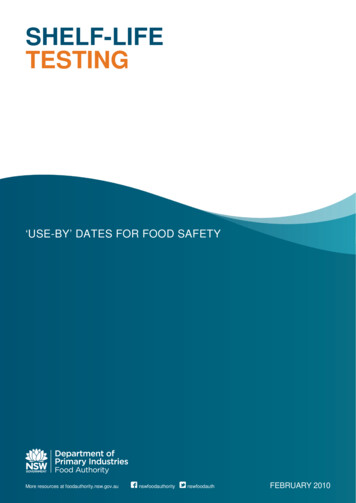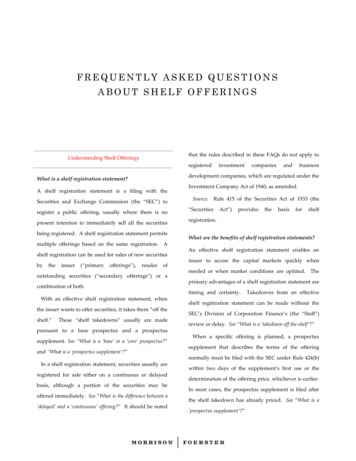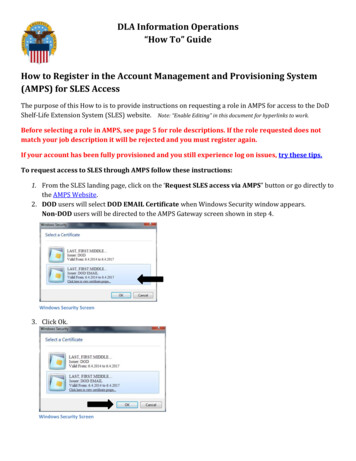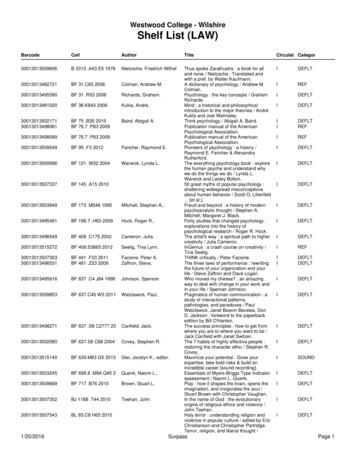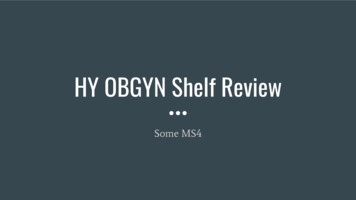
Transcription
HY OBGYN Shelf ReviewSome MS4
Introduction-Welcome to M3.-The key to doing well on rotations is to study early with a decent resource (ask upperclassmen),and get through (aka do and thoroughly review) the UWorld questions and 4 NBME practiceexams.-The review videos by Emma Ramahi/Onlinemeded are also clutch. Use them!-The OBGYN shelf is a management heavy shelf. The test writers are profoundly gifted at writingambiguous questions. To counter this, focus on first understanding the material and then beingfamiliar with case scenarios that buttress these concepts (our focus today).-3rd year builds on Step 1 material. Many exam questions depend on your ability to recognizedisease scripts (with unusual wording) that draw on pathophysiology you already know. It isespecially important in your studying to focus on risk factors for disease, sequential steps inmanagement of disease, and establishing a diagnosis in the context of clinical clues.
Introduction contd.-One of the strongest indicators of future success on Step 2 is strong performance onshelf exams. I would encourage you to study hard for and try to do well on theseexams. You’ll thank yourself next year. Unlike Step 1, there is no good comprehensivestep 2 resource.-To do well on NBME exams- don’t make assumptions (don’t pick an answer basedon something that is not there), pick the simple answer that has the most evidence,don’t overthink questions (just put everything together), mark questions you want toreturn to down the line (don’t spend 5 mins on a question with a first pass), study hard(the more you know, the better you’ll perform), and practice a lot (UWorld and othersespecially the NBMEs).-Disclaimer
Q1A 22 yo G1P1 female visits her obstetrician 1 week after she delivered a boy thatweighed 6 Lbs and 4 ounces. The delivery was unremarkable with APGAR scores of 8and 9 at 1 and 5 minutes respectively. The patient plans to have her next baby whenshe graduates from graduate school 2 years from now. In addition to routine screeningfor postpartum depression, what is the next best step in the management of thispatient?a. Discussion of the benefits of breastfeeding as an excellent long term form of birthcontrol.b. Cervical swabs for N. Gonorrhoeae and C. Trachomatis.c. Prescription for a combined oral contraceptive pill.d. Prophylactic sertraline for postpartum depression.e. Obtaining consent for the administration of depo medroxyprogesterone acetateduring this visit.
Q1 Key-The best answer here is E.-In the postpartum period, breastfeeding may be ok as birth control for a 6 mo period,however it is not completely reliable.-In a woman that expresses a desire for birth control postpartum, resist the temptation toprescribe anything containing estrogen (inhibits breastfeeding, C is wrong).-Progestin only contraceptives are the ideal option on your NBME. HY associations wrt tothese contraceptives include-the MOA revolving around thickening cervical mucus,protection against endometrial cancer, avoidance in the setting of breast cancer (or otherprogesterone receptor positive gynecologic malignancies), an association of injectableprogesterone with a delayed return to fertility after discontinuation (up to a year), possibleweight gain, and in some cases, a decrease in bone mineral density.-As an aside, treat breast mastitis with dicloxacillin.
Q1 Key contd.-It is also HY to know that breastfeeding is associated with a decreased risk of;Breast cancer-Prolactin shuts down GnRH which nukes estrogen production. Estrogendrives many breast cancers.Ovarian cancer-Prolactin shuts down GnRH which causes anovulation. Withanovulation, the ovarian epithelium does not have to be broken down and repairedeach month (which happens with ovulation). This reduces the potential for malignanttransformation of ovarian epithelium.-Breast feeding also helps with weight loss.-A woman with HIV, active TB, or active herpes lesions on the breast should notbreastfeed. Should a woman with mastitis (S. Aureus, give dicloxacillin) breastfeed?Galactosemia is also a contraindication to breastfeeding.
Q2Given the following clinical scenarios, what is the most likely diagnosis?22 yo F is tearful 3 days after delivery. She has been breastfeeding and taking good careof the baby.22 yo F is brought to the ED by her husband 3 days after delivery. He found a smallradio taped to her head. She claims to be receiving detailed instructions from outerspace on how sacrificing her baby would end world hunger.22 yo F comes to her 3 week postpartum visit. She looks dishevelled and admits tooccasionally having thoughts of hurting the baby which she feels remorseful about. Shehas been breastfeeding the baby but no longer enjoys activities she loved before shegot pregnant. She is accompanied by her husband who appears to be supportive.
Q2 KeyGiven the following clinical scenarios, what is the most likely diagnosis?22 yo F is tearful 3 days after delivery. She has been breastfeeding and taking good care of thebaby-Postpartum blues. Reassure the parent, avoid prescribing medications.22 yo F is brought to the ED by her husband 3 days after delivery. He found a small radio taped toher head. She claims to be receiving detailed instructions from outer space on how sacrificing herbaby would end world hunger-Postpartum psychosis (consider with hallucinations, hearingvoices, etc). Hospitalize involuntarily if need be, start an atypical/typical antipsychotic.22 yo F comes to her 3 week postpartum visit. She looks dishevelled and admits to occasionallyhaving thoughts of hurting the baby which she feels remorseful about. She has been breastfeedingthe baby but no longer enjoys activities she loved before she got pregnant. She is accompanied byher husband who appears to be supportive-Postpartum depression. The patient will match 5/9 ofthe SIGECAPS symptoms (including depressed mood or anhedonia) on your test. Don’t beswayed by the presence of only 4 symptoms. Prescribe an SSRI.
Q34 days after the cesarean delivery of a 9 Lb female, a 33 yo G2P2002 complains ofabdominal pain. Vital signs include BP 120/80, HR 99 bpm, RR 19 bpm, T 102.3.Physical exam is notable for diffuse lower abdominal tenderness and foul smellingvaginal discharge. A decision was made to pursue cesarean delivery secondary to anarrest of the active phase of labor. What is the most important risk factor for thispatient’s presentation?a.b.c.d.e.Multiple cervical exams.Maternal infection prior to delivery.Arrest of the active phase of labor.Fetal macrosomia.Cesarean delivery.
Q3 Key-As you probably know already, the NBME absolutely loves testing risk factors on 3rdyear shelf exams. As you go through the year, consider making a running list of riskfactors (and screening guidelines) for stuff. You’ll thank yourself on Step 2.-This patient has endometritis which is a uterine infection typically after delivery.Anything that can introduce external microbes to the internal environment of theuterus is a risk factor.-Cesarean delivery, multiple cervical checks, prolonged labor, prolonged rupture ofmembranes, and chorioamnionitis (infection of the amniotic fluid) all serve as RFs forendometritis. The most important however is cesarean delivery. E is correct.-The most common treatment regimen on NBMEs for endometritis is the combinationof clindamycin and gentamicin (ECG- Endometritis Clindamycin/Gentamicin).
Q3 Key contd.-For your exam, do not confuse endometritis with chorioamnionitis. Chorioamnionitisis an infection of the amniotic fluid. The HY RF here is a prolonged rupture ofmembranes.-The underlying mechanism here is the ascension of bugs up the vaginal tract aftermembranes are ruptured. Consider this as your dx in the setting of a prolonged ROMand tachycardia (HR 160) in the fetus (aka still not delivered) or in a Q stemdiscussing foul smelling amniotic fluid.-Treatment here is with ampicillin and gentamicin induce labor ASAP. If you seemention of a stillborn child with abscesses in multiple parts of the body in the settingof foul smelling amniotic fluid, consider Listeria as the offending agent(granulomatosis infantisepticum). Another weird HY scenario to be aware of is theneed to give GBS prophylaxis if a woman has ROMed for 18 hrs.
Diagnosing and Dating Pregnancy-Pregnancy is diagnosed with a B-HCG which can often be detected in the serum up to1 week before it can be detected in the urine.-Checking the B-HCG will be the next best step in management for a host ofpractice/real exam Q’s you’ll encounter - woman presenting with amenorrhea, womanpresenting with concerning signs for an ectopic pregnancy, etc.-A woman’s due date can be derived by adding 7 days to the first day of her LMP,subtracting 3 mo, and adding 1 year (Naegele’s Rule).-For example, a woman with the first day of her LMP being August 8 2017 will be dueon the 15th of May 2018 (add 7 days, August 15 2017; subtract 3 mo May 15 2017; Add 1year May 15 2018).
Other Pregnancy Basics-A woman that is G4P3104 has;Been pregnant 4 times (gravidity)Had 3 term pregnancies (term 37 weeks to 42 weeks).Had 1 preterm pregnancy (preterm 20 weeks but 37 weeks)Had 0 abortions (no pregnancy loss prior to 20 weeks).And has 4 living children (basically the sum of the last 3 numbers).This is the commonly used TPAL system. Remember that parity has to do with thenumber of children a woman has.
Q4-Do You Want To A Pregnant Millionaire?Match the pregnancy change to the most likely 1 liner;A blue/purple cervix and vaginaBlotchy pigmentation of the faceChanges in arterial blood pressure (first 20 weeks)Changes in arterial blood pressure (after 20 weeks)Plasma volume changesSystemic Vascular Resistance changes/Oncotic pressure changesCardiac output changesCardiac output changes with being supineRBC mass changesHgb/Hct changesLevels of coagulation factorsGastric motility/gastric emptying timeColonic motility/colonic transit timeEffects of gastric motility/colonic motility changesAcid base imbalance/Tidal volume changeUreteral size changesChanges in serum BUN/Cr/GFR/Creatinine ClearanceGlucose and Protein levels in the urinePituitary size changes/possible sequelae of this changeThyroid size change/TBG change/Total Thyroid hormone levels/Free thyroid hormoneB-HCG levels
Q4 Key-Do You Want To Be A Pregnant Millionaire?Match the pregnancy change to the most likely 1 liner;A blue/purple cervix and vagina-Chadwick’s sign (progesterone vasodilation increases vascularity).Blotchy pigmentation of the face-Chloasma.Changes in arterial blood pressure (first 20 weeks)-decrease (progesterone is a smooth muscle relaxant).Changes in arterial blood pressure (after 20 weeks)-increase (but still ends up being less than normal).Plasma volume changes-increases 50% (makes sense, mom loses blood during delivery, so she should prepare!)Systemic Vascular Resistance changes/Oncotic pressure changes-decrease (progesterone)/decrease (low albumin).Cardiac output changes-increase (HR and SV-from increased plasma volume-both go up).Cardiac output changes with being supine-decrease (uterus compresses the IVC).RBC mass changes-increase by 30% (O2 carrying capacity goes up).Hgb/Hct changes-decrease (remember that Hgb is a mass/volume ratio-plasma volume goes up more than RBC mass).Levels of coagulation factors-increase (pregnancy is a hypercoagulable state).Gastric motility/gastric emptying time-decrease/increase (predisposes to heartburn from reflux of gastric contents).Colonic motility/colonic transit time-decrease/increase-again all from progesterone mediated smooth muscle relaxationEffects of gastric motility/colonic motility changes-gastric reflux (heartburn)/constipation.Acid base imbalance/Tidal volume change-respiratory alkalosis secondary to hyperventilation (TV increases).Ureteral size changes-increase (from progesterone vasodilation), causes urinary stasis, increased UTI risk.Changes in serum BUN/Cr/GFR/Creatinine ose and Protein levels in the urine-increase (glucose transport maximum goes down in the PCT).Pituitary size changes/possible sequelae of this change-increase (producing more hormones)/Sheehan’s Syndrome.Thyroid size change/TBG change/Total Thyroid hormone levels/Free thyroid hormone-first 3 increase/last is unchanged.B-HCG levels-increase for first 10 weeks, then decrease, more HCG more vomiting (hyperemesis gravidarum).
Q5A 32 yo F at 36 weeks gestation comes to the ED because she has not felt her babymove for the past 36 hours. Physical exam reveals a distance of 37 cm from the pubicbone to the top of the uterus. No fetal cardiac tones are detected on dopplerultrasound. The rest of the exam is within normal limits. The patient’s blood pressureis 105/78, HR 78 bpm, RR 16 bpm, T 99.1 F. In addition to patient centered counselingand a demonstration of physician empathy, what is the next best step in themanagement of this patient?a.b.c.d.e.Transvaginal ultrasonography.Insertion of an internal uterine pressure catheter.Cesarean delivery of the deceased fetus.Induction of labor with IV Oxytocin.Discharge with return in 7 days for a planned C Section.
Q5 Key-The best answer here is D. With a deceased fetus, the next stepin management is to console the mom, respect her decisions, andconsider induction of labor with the goal of achieving a vaginaldelivery.-On the NBME exams, resist the temptation to offer a C-section.The risk of the surgery is not worth it.-You should also avoid options that involve leaving the baby inplace for a prolonged period of time to avoid sepsis and potentialdeath in the mom.
Q6A 25 yo primigravida at 10 weeks gestation presents for her first prenatal visit.Maternal exam and vital signs are within normal limits. Maternal Hb is 11g/dL andWBC is 6000. A most recent pap smear conducted 5 months earlier was unremarkable.Rubella titers are within normal limits. The patient is HbSAb ve, HbCAb -ve, andHbS
-The OBGYN shelf is a management heavy shelf. The test writers are profoundly gifted at writing ambiguous questions. To counter this, focus on first understanding the material and then being familiar with case scenarios that buttress these concepts (our focus today).-3rd year builds on Step 1 material. Many exam questions depend on your ability to recognize
